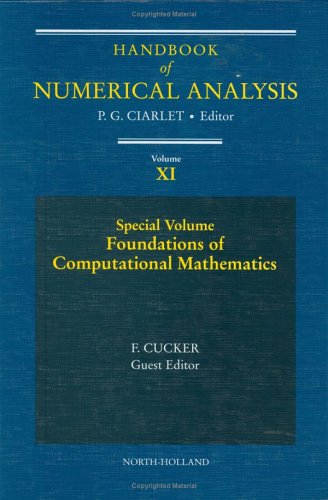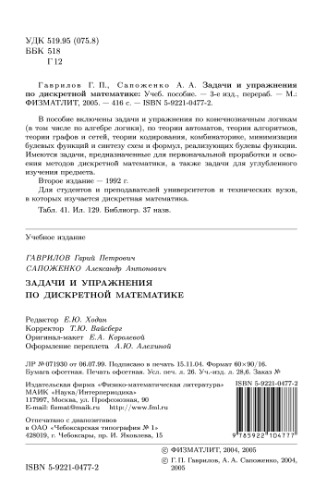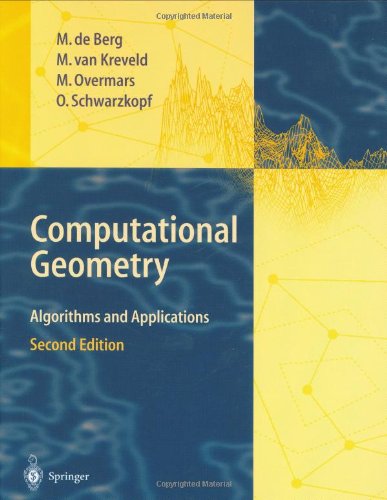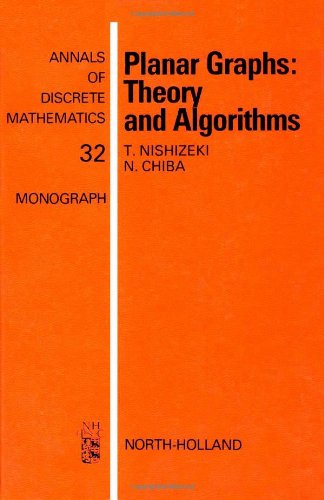F. Cucker, P. G. Ciarlet, J.L. Lions9780444512475, 0444512470
Table of contents :
0002.tif……Page 1
0001.tif……Page 2
Contents of Volume XI……Page 3
On the place of numerical analysis in the mathematical universe……Page 5
Approximation theory……Page 8
Functional analysis……Page 12
Complexity theory……Page 16
Probability theory and statistics……Page 18
Nonlinear dynamical systems……Page 21
Topology and algebraic geometry……Page 22
Differential geometry……Page 24
Abstract algebra……Page 26
…and beyond……Page 28
Adaptivity……Page 29
Conditioning……Page 30
Structure……Page 32
Acknowledgements……Page 33
References……Page 34
Geometric Integration and its Applications……Page 37
Introduction……Page 38
Qualitative properties……Page 40
A partial listing……Page 41
Why preserve structure?……Page 44
The theory of Hamiltonian methods……Page 45
Outline……Page 47
Symplectic Runge-Kutta methods……Page 51
Splitting and composition methods……Page 53
Example 1. The Harmonic oscillator……Page 56
Example 2. The pendulum……Page 59
Example 4. Stellar dynamics and the Kepler problem……Page 61
Error analysis – a brief overview……Page 63
The backward error analysis of symplectic methods……Page 64
An analysis of splitting methods……Page 66
Outline……Page 69
Serendipitous and enforced conservation laws……Page 70
Discrete gradient methods……Page 72
Lie group methods……Page 73
Example 1. Evolution on the sphere……Page 78
Example 2. Rigid body motion……Page 79
Symmetries and reversing symmetries……Page 81
Outline……Page 83
Numerical methods for scale invariant problems……Page 85
Examples……Page 88
A comparison of methods……Page 91
Overview……Page 96
Basic theory……Page 97
Examples……Page 98
Lagrangian and action based methods for PDEs……Page 101
Methods for partial differential equations that preserve all symmetries……Page 106
Noether’s theorem for discrete schemes……Page 111
Scaling invariance of partial differential equations……Page 114
Spatial adaptivity……Page 116
Singularities in the nonlinear Schrödinger equation (NLS)……Page 117
The nonlinear diffusion equation……Page 120
The Euler equation……Page 124
The Arakawa Jacobian……Page 125
Sine bracket type truncation……Page 126
The semi-geostrophic equations, frontogenesis and prediction ensembles……Page 127
Hamiltonian formulations……Page 130
Links with moving mesh theory……Page 131
Calculating Lyapunov exponents……Page 132
Conclusion……Page 134
Acknowledgements……Page 135
References……Page 136
A few words on linear programming……Page 143
A few words on complexity theory……Page 145
System of linear equations……Page 147
Linear least-squares problem……Page 148
System of linear inequalities (linear conic systems)……Page 149
Linear programming (LP)……Page 150
Semi-definite programming (SDP)……Page 153
Linear programming and complexity theory……Page 155
Finite precision and round-off errors……Page 156
Linear systems……Page 157
Condition-based complexity……Page 159
C(A)……Page 160
C(A)……Page 161
chiA……Page 163
sigma(A)……Page 164
Relations between condition measures for linear programming……Page 165
Interior point algorithms……Page 166
An example of complexity analysis: the Vavasis-Ye method……Page 172
Layered least squares……Page 175
One step of the algorithm……Page 179
Crossover events and LIP’s complexity……Page 183
An example of round-off (and complexity) analysis……Page 185
Introduction……Page 192
Proof of Theorem 6.3(i)……Page 193
Proof of Theorem 6.2……Page 195
Proof of Theorem 6.2 for sigma(A)……Page 196
Semidefinite programming algorithms and analyses……Page 197
Potential reduction algorithm……Page 198
Primal-dual algorithm……Page 203
Notes……Page 205
References……Page 206
Introduction……Page 211
Random product homotopy……Page 214
m-homogeneous structure……Page 217
Cheater’s homotopy……Page 226
Bernshteín’s theorem……Page 230
Mixed volume and mixed subdivisions……Page 236
Polyhedral homotopy method……Page 240
The polyhedral homotopy……Page 241
Solutions of binomial systems in (C*)n……Page 244
Polyhedral homotopy procedure……Page 247
Mixed volume computation……Page 249
A basic linear programming algorithm……Page 251
Finding all lower edges of a lifted point set……Page 253
Extending level-k subfaces……Page 258
Finding all mixed cells……Page 262
Semi-mixed polynomial systems……Page 263
The relation table……Page 266
Level-1 subfaces of S=(S(1),…, S(r))……Page 271
The extension of level-xi subfaces……Page 273
Finding all cells of type (k1,…,kr)……Page 274
Stable mixed volume……Page 275
An alternative algorithm……Page 277
A revision……Page 279
Solutions of positive dimension……Page 282
Fundamental procedure for following paths……Page 287
Projective coordinates and the projective Newton method……Page 290
Balancing the lifting values in polyhedral homotopies……Page 292
The end game……Page 300
Softwares……Page 301
References……Page 302
Further reading……Page 305
Preface……Page 307
Pioneers in chaotic dynamical system……Page 309
From order to chaos……Page 311
Li-Yorke theorem……Page 315
Snap-back repeller……Page 317
Euler’s difference scheme……Page 319
Yamaguti-Matano theorem……Page 320
Walrasian general equilibrium theory……Page 323
A mathematical model of an exchange economy……Page 324
Chaotic tatonnement……Page 325
O.D.E. with globally asymptotical stability……Page 328
Three types of O.D.E.’s and chaos with large time steps……Page 330
Three types of O.D.E.’s and chaos with small time step……Page 337
Lipschitz continuity at the equilibrium point……Page 341
Necessary condition for chaos……Page 344
Existence of stable periodic orbits……Page 348
Preliminary study……Page 349
Modified Euler scheme……Page 352
Central difference scheme……Page 357
Eigenvalues and eigenvectors at the fixed points……Page 359
Discretization of a system of ordinary differential equation……Page 360
Discretization of O.D.E. with one equilibrium……Page 364
Introduction……Page 374
A threshold model of collective behavior for a hairstyle fashion……Page 375
Multigrid difference scheme……Page 379
Lebesgue’s singular function and the Takagi function……Page 380
References……Page 382
Introduction……Page 385
Geodesic curves and minimal surfaces……Page 387
Energy based active contours…….Page 388
The geodesic curve flow…….Page 390
The level-sets geodesic flow: Derivation…….Page 394
The level-sets geodesic flow: Boundary detection…….Page 395
Existence, uniqueness, stability, and consistency of the geodesic model……Page 398
Experimental results……Page 401
Three-dimensional minimal surfaces……Page 402
Vector-valued edges……Page 404
Color snakes……Page 406
Remark on level-lines of vector valued images……Page 407
Finding the minimal geodesic……Page 408
Computing the minimal geodesic……Page 409
Equal distance contours computation…….Page 410
Affine invariant active contours……Page 411
Affine invariant gradient……Page 412
Affine invariant gradient snakes……Page 415
Additional extensions and modifications……Page 418
Tracking and morphing active contours……Page 420
Gaussian filtering and linear scale-spaces……Page 425
Edge stopping diffusion……Page 427
Perona-Malik formulation……Page 428
Robust estimation…….Page 429
Robust statistics and anisotropic diffusion……Page 432
Exploiting the relationship……Page 433
Robust estimation and line processes……Page 437
Directional diffusion……Page 440
Introducing prior knowledge……Page 441
The general technique……Page 443
Contrast enhancement……Page 446
Histogram modification……Page 448
Existence and uniqueness of the flow…….Page 449
Variational interpretation of the histogram flow…….Page 450
Experimental results……Page 452
Shape preserving contrast enhancement……Page 453
Acknowledgements……Page 455
References……Page 457
Further reading……Page 463
Subject Index……Page 465







Reviews
There are no reviews yet.